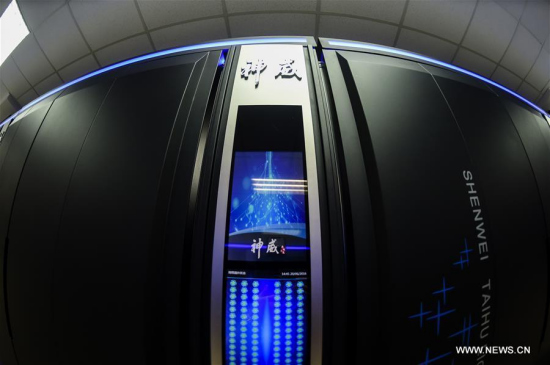
Photo taken on June 20, 2016 shows monitoring panel of Sunway TaihuLight, a new Chinese supercomputer, in Wuxi, east China's Jiangsu Province. (Photo/Xinhua)
It's no longer big news that a Chinese supercomputer dominates a list of the world's fastest machines these days, but a No. 1 system built using entirely made-in-China chips instead of U.S. technology is no doubt a milestone.
China's Sunway TaihuLight, which is capable of performing 93 quadrillion calculations per second (petaflop/s), was on Monday declared having replaced Tianhe-2 as the world's most powerful supercomputer on the so-called Top500 list.
Tianhe-2, also a Chinese system, had previously topped the list for the past three years with a performance of 33.86 petaflop/s, but it's built with U.S.-made Intel chips.
Monday's announcement marked a great leap forward in China's ambitions to develop its homegrown computing and chipmaking industry. It's no secret China has a deep worry over foreign reliance, especially after the U.S. government announced an export ban on all high-performance computing chips to China last year.
Now, China's persistent supercomputing investment seems to be paying off.
"The Sunway TaihuLight system, based on a homegrown processor, demonstrates the significant progress that China has made in the domain of designing and manufacturing large-scale computation systems," said Jack Dongarra, professor of the University of Tennessee and editor of the list, in a report about the new supercomputer.
He said Sunway TaihuLight is running "sizeable applications," a fact that caused him to believe the system "is capable of running real applications and not just a stunt machine."
Depei Qian, a professor at Beihang University and the chief scientist of China's 863 project on high productivity computer and grid service environment, called the new system a "landmark event."
"This is the first time we use domestic processors to take the top spot on the Top500 list, marking a big step in China's development of self-controllable supercomputers," Qian told Xinhua. "This system is not only leading in computing performance, but also has technological breakthroughs in areas including energy efficiency and size. It's very impressive."
Zizhong Chen, a supercomputer expert at the University of California, Riverside (UCR), said Chinese should be proud of the Sunway TaihuLight system.
"It shows that with long-term efforts of Chinese computer experts, China's IT technology is developing rapidly," said Chen. "It also means that China has mastered the main core technologies for building supercomputers and therefore China's ability to compete in the supercomputing domain is getting stronger and stronger."
What is equally surprising for the latest list is that China also has more supercomputers than the United States, with 167 compared to 165. This is the first time the United States has lost the lead.
"It's a trend with China," Dongarra told Xinhua. "They had zero systems in 2001 and today they surpass the United States. No other nation has seen such rapid growth."
Dongarra noted that supercomputers are "more important than ever" as they provide capability benefiting a broad range of industries, including energy, pharmaceutics, aircraft, automobile and entertainment.
Experts, however, were quick to point out that China is still far from being a real challenger or threat to U.S. supercomputing dominance.
"Overall, the United States is still in the lead, and Japan is also a strong contender," Qian said. "The U.S., Japan and Europe have an advantage over us in supercomputing applications, so China cannot be blindly optimistic."
Qian also said some Chinese systems on the latest list are not strictly supercomputers, but only systems such as data centers, which usually are not accounted for in the U.S. and Japan.
"So, the numbers aren't everything," he said.
The United States is now ready to regain lost ground. Last July, U.S. President Barack Obama signed an executive order to announce the National Strategic Computing Initiative, which aims to build supercomputer about 10 times faster than the Sunway TaihuLight system.
The U.S. Department of Energy has already allocated 525 million dollars to build three supercomputers with performances greater than 100 petaflop/s, which are expected to come into service around 2018.
Japan also is trying to stage a comeback with a new supercomputer project called Flagship 2020.
"We could see lead changes on the Top500's top position in the next few years, so we should treat that calmly," Qian said.
In order to enhance China's competitiveness in high performance computing, Chen of the UCR advised China to further strengthen development of supercomputer software and applications and training of computing talents, which he said still lagged behind when compared with the U.S., Japan and Europe.
Qian echoed similar problems, including lack of some kernel technologies, relying on imported commercial software and shortage of talents. "China has made some progress," he said, "but the weakness is also obvious."


















































